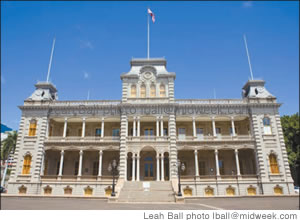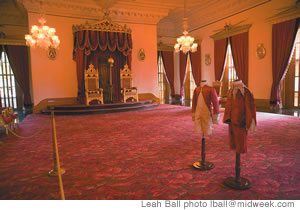Iolani, The Living Palace
Iolani Palace is a powerful symbol for modern Hawaiians more than a century after the overthrow, and remains a living treasure for all who walk its halls today. With all of the recent controversy at Iolani Palace, MidWeek took a tour last Monday of the only official residence of royalty left in the United States.

|
With all of the recent controversy at Iolani Palace, MidWeek took a tour last Monday of the only official residence of royalty left in the United States. (Hulihee Palace in Kona is privately built and owned.) What we found is that the palace is a link to Hawaii’s past, a teaching tool for the present and a living gift for future generations to perpetuate Hawaiian culture, keeping alive the stories of the Kamehamehas, King Kalakaua and Queen Lili’uokalani, and their legacies.
Our guide was the very informative docent educator Zita Cup Choy, who has been voluntarily giving palace tours for the past 30 years. She is one of the original palace docent class pupils.
King Kalakaua, the “Merrie Monarch,” completed building Iolani Palace in 1882, just 11 years before the monarchy’s overthrow. It cost him $360,000, and took three years and three architects. Building materials were imported from the Mainland, including slate for the roof from Pennsylvania, etched glass from San Francisco, cast iron columns for the veranda, and cedar wood from the Pacific Northwest to go along with native woods koa and kamani for the interior.
The palace was the official residence of the Hawaiian monarchy which ruled the Islands for about 100 years and whose ancestors ruled here in separate individual kingdoms more than 1,000 years prior to that. Portraits of Kamehameha I, his son Liholiho Kamehameha II, Kamehameha III, IV and V, along with King Kalakaua are proudly displayed on the wall surrounding the grand staircase. The staircase is one of the largest koa wood structures in the world and its steps are the only remaining original flooring at the palace. Most of the palace’s glass is also original.
The palace suited Kalakaua and his wife, Queen Kapiolani, as they enjoyed parties and entertaining guests, Cup Choy explains.
“During the Monarchy period, there were many functions held here,” says Cup Choy. “Had you been invited to such an event, you would receive a hand-engraved invitation. On the day of the event, we would arrive by coach and come up to the front gate, which was open only for formal events. Guests were led in by uniformed staff.
“I like to imagine that my guests and I are invited here for a meal of some kind. Kalakaua entertained at breakfast more than any other meal.”
Were you a guest for breakfast at the palace, you would have waited in the Blue Room, named for its blue furniture, for your meal to be announced. Informal introductions were held here, Cup Choy says. Queen Kapiolani and Kalakaua’s sister Lili’uokalani hosted afternoon teas in this room.
“We ladies would have been invited: We would have come dressed in some of our finest clothing and we would have been served light refreshments. We would have enjoyed musical entertainment provided by the Royal Hawaiian Band.”
Moving on to the dining room, Cup Choy says it is the most European-looking room both in how it was used and how it was furnished. The chairs are from Boston and are part of a set of more than 200 pieces of furniture manufactured by the AH Davenport Company. Food, she says, was prepared in the kitchen, which was located in the basement, and brought up to this floor by a dumb waiter. Guests would have been served by uniformed staff members. The table was set with European linen, Bohemian crystal and possibly a flat-ware set that was a gift from Napoleon III to one of the Kamehameha.

|
“If we’d been here for breakfast or lunch in 1883, we would have started our meal with fruit and continued with fish. Shrimp curry, chicken salad, eggs and to finish off breakfast, ice cream,” she says.
“How long do you suppose we would have been here?” she then asks. In Pacific Paradise Magazine it was reported, she goes on to explain, that one breakfast started at 9:30 a.m. and that the guests left at noon.
“For a meal, Kalakaua tended to invite local residents and their business associates, family and friends who were in transit so he could learn more about the rest of the world - not just the geographic world, but the business world as well. He’d invite you and pick your brain about your job and about your new technology,” Cup Choy says.
Speaking of 1880s technology, when Kalakaua had the palace built he also brought a lot of ideas from European and Oriental court life to Hawaii. When Iolani Palace was first built, it was lit by gas. He eventually had the palace wired for electricity after meeting Thomas Edison and seeing a display of electric lights while in Paris. Iolani Palace had electricity four years before the White House, and four years before Hawaiian Electric was established. Kalakaua’s love of modern things expanded to outfitting the palace with hot and cold running water, indoor plumbing in his bathroom, and a telephone in his study so he could call his chamberlain’s office downstairs.
“Some people have asked what Kalakaua would have thought of computers. I think he would have been best buddies with Bill Gates,” says Cup Choy.
On the second floor were the private living quarters of King Kalakaua and Queen Kapiolani, although they didn’t do much living at the palace. The king and queen apparently preferred their other residences for their off-duty hours, says Cup Choy. There were homes on the Neighbor Islands, there were homes in the Waikiki area.
“Those were considered country homes,” she explains. “They’d go there for long weekends to get away from the busy city.”
Also on the second floor is the room where Queen Lili’uokalani, Kalakaua’s successor, was held prisoner by the Republic of Hawaii government for about eight months. During that time she was initially not allowed writing materials or her musical instruments, so she began making a quilt to tell her story of what happened to her and who she was. She completed the quilt at her residence, Washington Place, following her release from imprisonment. The quilt is displayed at the palace in the room where Lili’uokalani was held.
The nonprofit Friends of Iolani Palace began restoration on the
Page 1 of 2 pages for this story 1 2 >
E-mail this story | Print this page | Comments (0) | Archive | RSS
Most Recent Comment(s):








